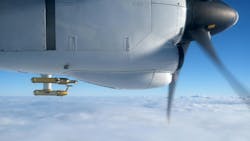Detecting supercooled water droplets in flight
COLOGNE, Germany - The accumulation of large droplets of supercooled water on aircraft can pose a challenge for flight operations. Ice formations that result from Supercooled Large Droplets (SLD) can form in positions where ice protection systems cannot reach. Additionally, this ice tends to grow faster than other types of 'icing', such as from smaller water droplets. The EU project SENS4ICE (SENSors and certifiable hybrid architectures for safer aviation in ICing Environment) was led by the German Aerospace Center (Deutsche Zentrum für Luft- und Raumfahrt; DLR) in cooperation with 16 project participants, and has investigated new technologies to detect SLD icing, reports the German Aerospace Center. Continue reading original article.
The Military & Aerospace Electronics take:
13 March 2024 - The DLR writes that "During the five-year project, researchers developed ten technologies to directly detect ice in flight. They then successfully tested them in icing wind tunnels under both small droplet and SLD icing conditions. One of these new technologies is the Local Ice Layer Detector (LILD), developed by the DLR Institute of Lightweight Systems, which can be integrated on to aircraft structures such as wings or tails. The LILD analyzed how ultrasonic waves are influenced by aircraft icing, that is, how they change as ice accretes on the aircraft.
"Other researchers developed aircraft sensor technologies based on thermal, optical and electrical principles, while some methods investigated the identification of SLD conditions using satellite data – which would also improve weather forecasts."
Related: Deutsche Aircraft delivers D328TM to German Aerospace Center as next flying test lab
Related: The German Aerospace Center (DLR) researches flexible wing surfaces
Jamie Whitney, Senior Editor
Military + Aerospace Electronics
